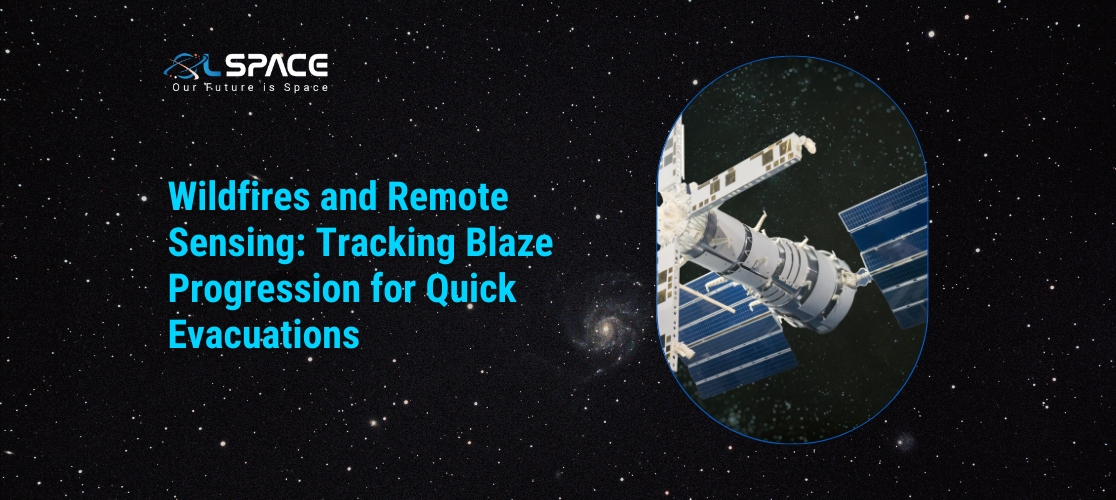07 November 2023
Wildfires and Remote Sensing: Tracking Blaze Progression for Quick Evacuations

Wildfires pose a significant threat to both human life and the environment. In recent years, the use of remote sensing technology has become instrumental in tracking wildfire progression and providing critical information for quick evacuations and effective firefighting efforts. In this blog, we will explore how remote sensing technology is employed to monitor wildfires, assess their behavior, and enable swift and informed decision-making during wildfire events.
The Wildfire Challenge
Wildfires are often unpredictable and can spread rapidly, making early detection and response crucial. Traditional methods of tracking wildfires, such as ground-based observations and aircraft surveillance, have limitations. They may not provide comprehensive information, are often hindered by difficult terrain and hasardous conditions, and can result in delays in issuing evacuation orders.
The Role of Remote Sensing
1. Remote sensing involves the use of satellites, drones, and other sensors to collect data and imagery from a distance. In the context of wildfires, remote sensing technology has several key applications:
2. Early Detection: Satellites equipped with infrared sensors can detect the heat and smoke produced by wildfires. This enables the early identification of fire outbreaks, often before they are visible to the naked eye.
3. Monitoring Fire Behavior: Remote sensing technology can provide real-time information about the progression of a wildfire, including its direction, speed, and the areas it has affected. This data is crucial for developing containment strategies.
4. Identifying Hotspots: High-resolution satellite imagery and aerial drones can pinpoint hotspots and areas of intense fire activity, helping firefighting teams prioritise resources.
5. Assessing Smoke and Air Quality: Remote sensing can track smoke plumes, monitor air quality, and predict the dispersion of pollutants, providing valuable information for public health and safety.
6. Mapping Burn Scars: After a wildfire is contained, remote sensing can be used to map the burn scars and assess the extent of the damage. This data is essential for recovery and rehabilitation efforts.
Satellite-Based Remote Sensing
Satellites play a critical role in wildfire monitoring. Key features of satellite-based remote sensing for wildfire tracking include:
1. Frequent Passes: Satellites orbit the Earth multiple times a day, providing frequent passes over regions. This allows for real-time or near-real-time monitoring of wildfires.
2. Global Coverage: Satellites can capture data from virtually anywhere on Earth, making them effective for tracking wildfires in remote or inaccessible areas.
3. Multi-Spectral Imaging: Satellites are equipped with various sensors, including infrared and thermal imaging, which can detect different aspects of wildfires, such as heat and smoke.
4. Data Sharing: Satellite data is often shared with relevant agencies, firefighting teams, and the public, facilitating timely decision-making and public safety.
Drone-Based Remote Sensing
Drones, or Unmanned Aerial Vehicles (UAVs), offer the advantage of low-altitude, close-range imaging. Their applications in wildfire monitoring include:
1. Rapid Response: Drones can be deployed quickly to assess wildfire conditions in real time, aiding firefighting efforts and evacuation decisions.
2. High-Resolution Imagery: Drones can capture high-resolution images and videos, enabling detailed monitoring of wildfire behavior.
3. Terrain Accessibility: Drones can access rugged or hasardous terrain where traditional methods may be impractical.
Integration with Geographic Information Systems (GIS)
Remote sensing data is often integrated into Geographic Information Systems (GIS), providing a powerful tool for visualising and analysing wildfire-related information. GIS platforms allow for the creation of maps, overlays of critical data (such as wind patterns and population density), and the development of evacuation and containment strategies.
Conclusion
Wildfires are a growing concern, and the ability to monitor and respond to these events rapidly is paramount. Remote sensing technology, including satellites and drones, offers valuable data and imagery that aids in early detection, monitoring, and assessment of wildfires. By using remote sensing and GIS technology, authorities and firefighting teams can make informed decisions, issue timely evacuation orders, and strategise containment efforts, ultimately contributing to the safety of communities and the environment in the face of wildfire threats.
